Parisian bridges are weighted down with copycat "love locks," while visitors crowd cheek-to-jowl into Barcelona churches and Dubrovnik's historic center. In Italy, attempts to manage the impact of tourism range from segregating visitors to fines for flip-flops.
As a glut of anxious headlines document overtourism, it's easy to think that the planet is simply full.
But stray from the well-worn tourist trails, and you'll discover another travel story entirely. In much of the world, there are places that are eager to welcome tourists -- and when practiced sustainably, where tourism can even help alleviate poverty.
The contrast between the most- and least-visited places is stark. In 2017, nearly 87 million international tourists arrived in France. That same year, a mere 2,000 international tourists visited the South Pacific country of Tuvalu, where it's easy to find a beach -- or even an entire island -- to yourself.
Based on the most recent data compiled by the United Nations World Tourism Organization, this list reflects many of the world's least-visited countries and overseas territories, where you'll find gorgeous natural beauty, culture and history without pushing through a thicket of selfie sticks.
It's sadly incomplete. Some of the most magnificent places on Earth -- including Guinea-Bissau's lush jungle and the expansive shores of Lake Chad -- have been excluded because of safety recommendations from the US Department of State.
What remains, though, shows just how rewarding it can be to leave the popular sites behind, whether you're lounging on Sierra Leone beaches, exploring Liechtenstein's mountaintop castles or shipwreck diving in the South Pacific.
And if you can't picture a week in Kiribati or imagine the flavour of Timor Leste's traditional cuisine, it's OK. By spinning the globe and booking a flight to a country you know little about, you'll infuse the journey with a sense of wonder. That, after all, is what travel is for.
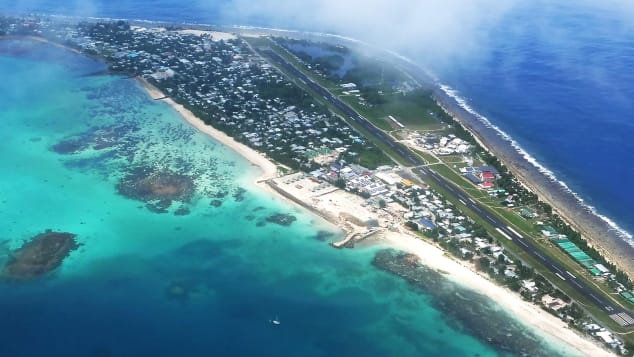 Tuvalu is among the world's most isolated nations. Fiona Goodall/Getty Images
With more than 100 tiny islands scattered across the South Pacific, the country of Tuvalu is among the world's most isolated nations.
Only the main island, Funafuti, has an airport. From there, travellers continue to the outlying communities by passenger ferry. Free from the crowds that fill beaches in popular destinations like Fiji, these islands are an untouristed haven where you can watch flying fish skim the water, spend a lazy afternoon in a hammock or snorkel candy-hued coral reefs.
If you're planning a trip to Tuvalu, don't wait: The waves that lap Tuvalu's stilt houses have long been seen as an existential threat here, since rising seas could swamp the low-lying country.
Why go: Stroll powdered sugar beaches at risk from rising sea levels.
International tourist arrivals in 2017: 2,000
Tuvalu is among the world's most isolated nations. Fiona Goodall/Getty Images
With more than 100 tiny islands scattered across the South Pacific, the country of Tuvalu is among the world's most isolated nations.
Only the main island, Funafuti, has an airport. From there, travellers continue to the outlying communities by passenger ferry. Free from the crowds that fill beaches in popular destinations like Fiji, these islands are an untouristed haven where you can watch flying fish skim the water, spend a lazy afternoon in a hammock or snorkel candy-hued coral reefs.
If you're planning a trip to Tuvalu, don't wait: The waves that lap Tuvalu's stilt houses have long been seen as an existential threat here, since rising seas could swamp the low-lying country.
Why go: Stroll powdered sugar beaches at risk from rising sea levels.
International tourist arrivals in 2017: 2,000
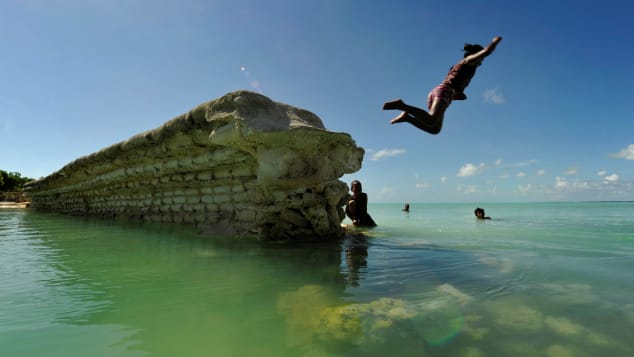 Kiribati's beauty is matched by its remoteness.
The AGE/Fairfax Media/Fairfax Media via Getty Images
Scatter-shot atolls and lagoons barely peek above the central Pacific waters in Kiribati, whose islands and atolls cluster into three groups: the Gilbert, Phoenix and Line Islands.
It's hard to overstate the isolation of these faraway isles -- neighbouring Fiji is relatively close at 1,394 miles away -- and few travelers make the journey here. Those that do, however, will be treated to a rich tradition of hospitality. While not every visitor will secure an invitation to a traditional feast, or botaki, many have.
If you're lucky enough to attend, you might see dancers in pandanus skirts, listen to drums beating out a traditional rhythm then dine on breadfruit, taro and sprouted coconut.
Why go: Experience a botaki in an open-air maneaba, or meeting house.
International tourist arrivals in 2016: 6,000
Read about why Kiribati celebrates the new year earlier than almost anyone else.
Kiribati's beauty is matched by its remoteness.
The AGE/Fairfax Media/Fairfax Media via Getty Images
Scatter-shot atolls and lagoons barely peek above the central Pacific waters in Kiribati, whose islands and atolls cluster into three groups: the Gilbert, Phoenix and Line Islands.
It's hard to overstate the isolation of these faraway isles -- neighbouring Fiji is relatively close at 1,394 miles away -- and few travelers make the journey here. Those that do, however, will be treated to a rich tradition of hospitality. While not every visitor will secure an invitation to a traditional feast, or botaki, many have.
If you're lucky enough to attend, you might see dancers in pandanus skirts, listen to drums beating out a traditional rhythm then dine on breadfruit, taro and sprouted coconut.
Why go: Experience a botaki in an open-air maneaba, or meeting house.
International tourist arrivals in 2016: 6,000
Read about why Kiribati celebrates the new year earlier than almost anyone else.
 The waters around the Marshall Islands are home to spectacular scuba diving sites. Reinhard Dirscherl/ullstein bild/Getty Images
Bombs and bathing suits put these Pacific isles on the world's radar -- bikinis were named for the United States' nuclear testing on the Marshall Islands' Bikini Atoll.
Decades later the island is still radioactive, as is the test site at Enewetak Atoll, but the waters surrounding Bikini Atoll have become one of the world's most spectacular scuba diving sites.
There are more than a dozen shipwrecks on the seafloor near Bikini Atoll. Make your first dive to see the aircraft carrier USS Saratoga, which was present at the Battle of Iwo Jima before the US military used the ship for nuclear target practice. Divers will find deck guns blooming into colorful coral reefs, and schools of fish threading between bombs still strapped to the ship's metal decks.
Why go: Scuba dive into a ship graveyard transformed into an eerie underwater playground.
International tourist arrivals in 2017: 6,000
Follow an interactive journey to the Marshall Islands.
The waters around the Marshall Islands are home to spectacular scuba diving sites. Reinhard Dirscherl/ullstein bild/Getty Images
Bombs and bathing suits put these Pacific isles on the world's radar -- bikinis were named for the United States' nuclear testing on the Marshall Islands' Bikini Atoll.
Decades later the island is still radioactive, as is the test site at Enewetak Atoll, but the waters surrounding Bikini Atoll have become one of the world's most spectacular scuba diving sites.
There are more than a dozen shipwrecks on the seafloor near Bikini Atoll. Make your first dive to see the aircraft carrier USS Saratoga, which was present at the Battle of Iwo Jima before the US military used the ship for nuclear target practice. Divers will find deck guns blooming into colorful coral reefs, and schools of fish threading between bombs still strapped to the ship's metal decks.
Why go: Scuba dive into a ship graveyard transformed into an eerie underwater playground.
International tourist arrivals in 2017: 6,000
Follow an interactive journey to the Marshall Islands.
 Montesrrat's landscape is shaped by volcanoes. Sebastian Widmann/dpa/AP
Velvety green hills pinch towards the rim of Montserrat's Soufrière Hills volcano, whose incendiary force has shaped the landscape of this Caribbean island.
Much of Montserrat was overshadowed by volcanic eruptions in the 1990s, when the capital city of Plymouth was buried under a deep layer of ash and volcanic stone. Now, visitors come by plane or ferry from the nearby island of Antigua to see the fallout of the volcano's furious power.
Tours of Plymouth reveal a 17th-century church turned gray with ash and the ruins of a once-grand hotel.
Why go: See a modern-day Pompeii, then lounge on new beaches created from crumbling volcanic stone.
International tourist arrivals in 2017: 8,000
Montesrrat's landscape is shaped by volcanoes. Sebastian Widmann/dpa/AP
Velvety green hills pinch towards the rim of Montserrat's Soufrière Hills volcano, whose incendiary force has shaped the landscape of this Caribbean island.
Much of Montserrat was overshadowed by volcanic eruptions in the 1990s, when the capital city of Plymouth was buried under a deep layer of ash and volcanic stone. Now, visitors come by plane or ferry from the nearby island of Antigua to see the fallout of the volcano's furious power.
Tours of Plymouth reveal a 17th-century church turned gray with ash and the ruins of a once-grand hotel.
Why go: See a modern-day Pompeii, then lounge on new beaches created from crumbling volcanic stone.
International tourist arrivals in 2017: 8,000
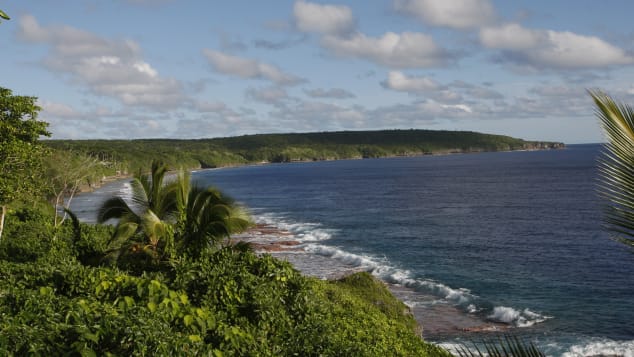 The waters off Niue's rugged coastline are used as a nursery by humpback whales. Nick Perry/AP
If your image of a Polynesian island is all gentle waves and soft sand, think again: Niue's rugged and cave-pocked coast is etched in sharp coral.
From July through October, humpback whales use Niue as a warm-water nursery, lolling close enough to the island to be spotted from shore. During those months, the sound of the whales' songs and slapping tails can be heard above the sea breeze.
Here, visitors can even join trained guides to swim with the humpback whales, one of the few places on earth where it's possible.
Why go: Swim alongside school bus-sized whales in one of the world's smallest countries.
International tourist arrivals in 2017: 10,000
The waters off Niue's rugged coastline are used as a nursery by humpback whales. Nick Perry/AP
If your image of a Polynesian island is all gentle waves and soft sand, think again: Niue's rugged and cave-pocked coast is etched in sharp coral.
From July through October, humpback whales use Niue as a warm-water nursery, lolling close enough to the island to be spotted from shore. During those months, the sound of the whales' songs and slapping tails can be heard above the sea breeze.
Here, visitors can even join trained guides to swim with the humpback whales, one of the few places on earth where it's possible.
Why go: Swim alongside school bus-sized whales in one of the world's smallest countries.
International tourist arrivals in 2017: 10,000
 Matafao Peak dominates the skyline above Pago Pago Harbour. Torsten Blackwood/AFP/Getty Images
Steeply pitched islands drop towards crystalline water in American Samoa, a South Pacific island group northeast of Fiji that's the only US territory in the Southern Hemisphere.
Whether you're skimming Pago Pago Harbor in an outrigger canoe or casting a line for hefty tuna and marlin, there are endless ways to explore the sea here. To find the treasures hidden in the dense forest canopy, head to the National Park of American Samoa for a trek through fruit bat country.
The Samoan fruit bat has a wingspan of up to three feet, and the fuzzy mammals can be spotted dangling from trees or swooping through the air in search of fresh fruit and nectar.
Why go: Hang with the endangered fruit bats of the National Park of American Samoa.
International tourist arrivals in 2017: 20,000
Matafao Peak dominates the skyline above Pago Pago Harbour. Torsten Blackwood/AFP/Getty Images
Steeply pitched islands drop towards crystalline water in American Samoa, a South Pacific island group northeast of Fiji that's the only US territory in the Southern Hemisphere.
Whether you're skimming Pago Pago Harbor in an outrigger canoe or casting a line for hefty tuna and marlin, there are endless ways to explore the sea here. To find the treasures hidden in the dense forest canopy, head to the National Park of American Samoa for a trek through fruit bat country.
The Samoan fruit bat has a wingspan of up to three feet, and the fuzzy mammals can be spotted dangling from trees or swooping through the air in search of fresh fruit and nectar.
Why go: Hang with the endangered fruit bats of the National Park of American Samoa.
International tourist arrivals in 2017: 20,000
 Sunken seaplanes, oil tankers and submarines make the Solomon Islands a subaquatic museum. Prisma by Dukas/Universal Images Group Editorial/UIG via Getty Images
Desperate battles unfolded against a paradise-island backdrop in this South Pacific archipelago after US Marines landed on Guadalcanal Island in 1942.
Decades after the last skirmish, the lush jungle holds rusting tanks, amphibious vehicles and fox holes that are a haunting reminder of that era. And the history doesn't stop at the waterline.
Sunken seaplanes, oil tankers and submarines are strewn across the ocean floor, sprouting coral formations on corroded metal sheathings. For travelers who snorkel or scuba dive, exploring the Solomon Islands is the chance to watch sea life colonize the remnants of a brutal war.
Why go: Discover Second World War history in a vast archipelago.
International tourist arrivals in 2017: 26,000
Read about the best private islands on earth -- including one in the Solomon Islands.
Sunken seaplanes, oil tankers and submarines make the Solomon Islands a subaquatic museum. Prisma by Dukas/Universal Images Group Editorial/UIG via Getty Images
Desperate battles unfolded against a paradise-island backdrop in this South Pacific archipelago after US Marines landed on Guadalcanal Island in 1942.
Decades after the last skirmish, the lush jungle holds rusting tanks, amphibious vehicles and fox holes that are a haunting reminder of that era. And the history doesn't stop at the waterline.
Sunken seaplanes, oil tankers and submarines are strewn across the ocean floor, sprouting coral formations on corroded metal sheathings. For travelers who snorkel or scuba dive, exploring the Solomon Islands is the chance to watch sea life colonize the remnants of a brutal war.
Why go: Discover Second World War history in a vast archipelago.
International tourist arrivals in 2017: 26,000
Read about the best private islands on earth -- including one in the Solomon Islands.
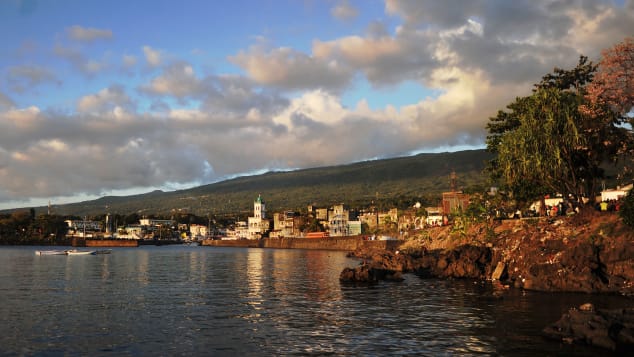 The islands of Comoros are often called the "Perfume Isles." Tony Karumba/AFP/Getty Images
Cupped in the ocean between Madagascar and Mozambique, Comoros has the kind of clear water and pale beaches that draw travelers to the Seychelles -- but with few tourists and little development.
There's something in the air here, too. Often called the "Perfume Isles," the islands of Comoros have been cultivating aromatic plants for making scents since the French colonial era.
Now, the blossoms of the ylang-ylang tree infuse the breeze with an evocative aroma, mixing with cloves, bergamot, jasmine, vanilla and lemongrass to intoxicating effect.
Why go: Breathe the perfumed air of an island that overflows with blooms.
International tourist arrivals in 2017: 28,000
Need more reasons to visit Comoros? Here are five.
The islands of Comoros are often called the "Perfume Isles." Tony Karumba/AFP/Getty Images
Cupped in the ocean between Madagascar and Mozambique, Comoros has the kind of clear water and pale beaches that draw travelers to the Seychelles -- but with few tourists and little development.
There's something in the air here, too. Often called the "Perfume Isles," the islands of Comoros have been cultivating aromatic plants for making scents since the French colonial era.
Now, the blossoms of the ylang-ylang tree infuse the breeze with an evocative aroma, mixing with cloves, bergamot, jasmine, vanilla and lemongrass to intoxicating effect.
Why go: Breathe the perfumed air of an island that overflows with blooms.
International tourist arrivals in 2017: 28,000
Need more reasons to visit Comoros? Here are five.
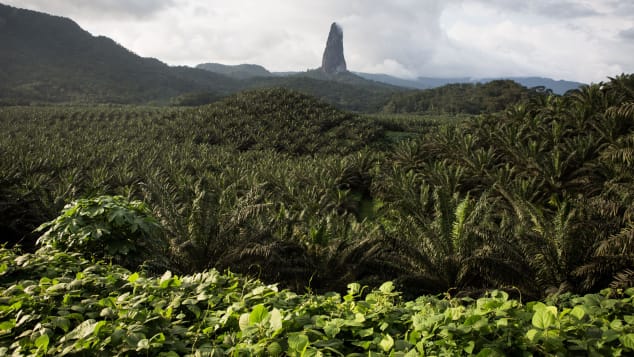 São Tomé and Principe are a biodiversity hotspot. Ruth McDowall/AFP/Getty Images
Making up a nearly equatorial nation in west Africa's Gulf of Guinea, the islands of São Tomé and Príncipe are packed with endemic plants and animals.
In the lush jungle that has overtaken former coffee plantations here, travelers might find begonias growing high as a house, hundreds of orchid species and birds in every hue.
For a nature-lover's introduction to this biodiversity hotspot, start by flying into the main island of São Tomé then continue by small plane to tiny Príncipe. The volcanic island is a UNESCO Biosphere Reserve, and new species are discovered here on a regular basis, from reed frogs to owls.
Peer carefully into the foliage, and you may spot a blooming flower or furtive creature that's yet to be documented by scientists.
Why go: Search for undiscovered species in a biodiversity hot spot.
International tourist arrivals in 2016: 29,000
São Tomé and Principe are a biodiversity hotspot. Ruth McDowall/AFP/Getty Images
Making up a nearly equatorial nation in west Africa's Gulf of Guinea, the islands of São Tomé and Príncipe are packed with endemic plants and animals.
In the lush jungle that has overtaken former coffee plantations here, travelers might find begonias growing high as a house, hundreds of orchid species and birds in every hue.
For a nature-lover's introduction to this biodiversity hotspot, start by flying into the main island of São Tomé then continue by small plane to tiny Príncipe. The volcanic island is a UNESCO Biosphere Reserve, and new species are discovered here on a regular basis, from reed frogs to owls.
Peer carefully into the foliage, and you may spot a blooming flower or furtive creature that's yet to be documented by scientists.
Why go: Search for undiscovered species in a biodiversity hot spot.
International tourist arrivals in 2016: 29,000
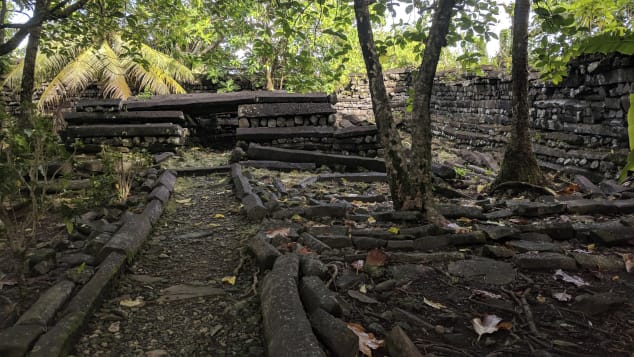 The ancient city of Nan Madol is home to grand basalt palaces and temples. Nicole Evatt/AP
If you plan to spend one day on every island in the Federated States of Micronesia (FSM), you'll need more than a year and a half to explore the Pacific nation. There are 607 islands here, but put them together and they add up to a mere 271 square miles of land -- and that's spread across nearly 2.6 million square miles of water.
Many of the islands are uninhabited. But exploring Pohnpei, the largest island in the FSM, is a fascinating reminder that the archipelago's been shaped by humans for centuries.
Off the island's southeastern coast is the UNESCO World Heritage Site of Nan Madol, which comprises 100 man-made islets created by a great Pacific dynasty. Here, travelers can explore grand basalt palaces and temples constructed at the center's apex between 1,200 and 1,500 AD.
Why go: Visit an ancient ceremonial center rising from the ocean.
International tourist arrivals in 2016: 30,000
Read about how Nan Madol inspired the horror writer H.P. Lovecraft.
The ancient city of Nan Madol is home to grand basalt palaces and temples. Nicole Evatt/AP
If you plan to spend one day on every island in the Federated States of Micronesia (FSM), you'll need more than a year and a half to explore the Pacific nation. There are 607 islands here, but put them together and they add up to a mere 271 square miles of land -- and that's spread across nearly 2.6 million square miles of water.
Many of the islands are uninhabited. But exploring Pohnpei, the largest island in the FSM, is a fascinating reminder that the archipelago's been shaped by humans for centuries.
Off the island's southeastern coast is the UNESCO World Heritage Site of Nan Madol, which comprises 100 man-made islets created by a great Pacific dynasty. Here, travelers can explore grand basalt palaces and temples constructed at the center's apex between 1,200 and 1,500 AD.
Why go: Visit an ancient ceremonial center rising from the ocean.
International tourist arrivals in 2016: 30,000
Read about how Nan Madol inspired the horror writer H.P. Lovecraft.
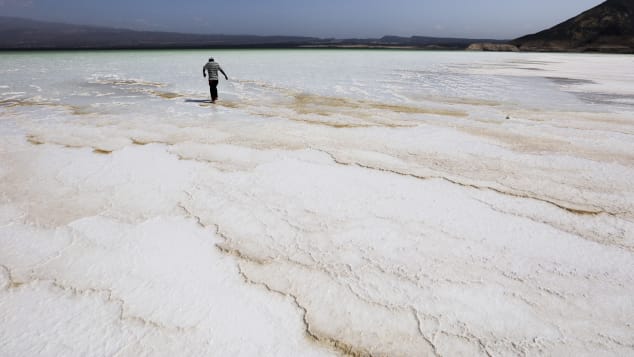 Djibouti's landscape can seem otherworldy.
South China Morning Post/South China Morning Post/South China Morning Post via Get
Perched at the confluence of the Red Sea and the Gulf of Aden, Djibouti has a strategic location -- but the landscape itself can seem otherworldly.
White-salt beaches ring the hyper-saline Lake Assal, steam pours from the Ardoukoba Volcano and camels graze amidst lunar towers in Lake Abbé.
There, travelers can spot bubble gum-colored flamingos that lend the otherwise desolate scene a rococo flourish. It's a testament to human ingenuity that the nomadic Afar people have carved a life in this harsh environment, leading their flocks to graze on widely scattered pockets of marsh grass.
Why go: Have an off-planet experience without the costly space flight.
International tourist arrivals in 2010: 51,000
Djibouti's landscape can seem otherworldy.
South China Morning Post/South China Morning Post/South China Morning Post via Get
Perched at the confluence of the Red Sea and the Gulf of Aden, Djibouti has a strategic location -- but the landscape itself can seem otherworldly.
White-salt beaches ring the hyper-saline Lake Assal, steam pours from the Ardoukoba Volcano and camels graze amidst lunar towers in Lake Abbé.
There, travelers can spot bubble gum-colored flamingos that lend the otherwise desolate scene a rococo flourish. It's a testament to human ingenuity that the nomadic Afar people have carved a life in this harsh environment, leading their flocks to graze on widely scattered pockets of marsh grass.
Why go: Have an off-planet experience without the costly space flight.
International tourist arrivals in 2010: 51,000
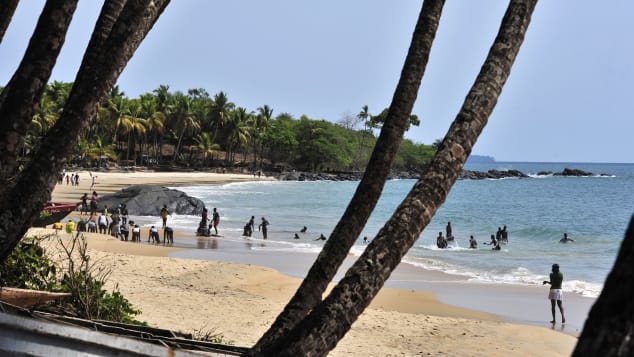 Tokeh beach near Freetown has bone-white sand.
Issouf Sanogo/AFP/Getty Images
If thinking of Sierra Leone doesn't inspire daydreams of powdery beaches, surf breaks and nesting sea turtles, you might need an update.
From civil war to Ebola outbreaks, this west African country has faced hard knocks in recent decades, but that's one more reason to support the slowly recovering tourist economy.
Stake out a sunny piece of sand on the Western Peninsula, and you can sip a locally brewed Star Lager as you scan the waterline for sea turtles.
Why go: Picture-postcard beach vacations way off the tourist map. Did we mention there are pygmy hippos here?
International tourist arrivals in 2016: 54,000
Read about Africa's 25 best beaches -- including a white-sand stunner in Sierra Leone.
Tokeh beach near Freetown has bone-white sand.
Issouf Sanogo/AFP/Getty Images
If thinking of Sierra Leone doesn't inspire daydreams of powdery beaches, surf breaks and nesting sea turtles, you might need an update.
From civil war to Ebola outbreaks, this west African country has faced hard knocks in recent decades, but that's one more reason to support the slowly recovering tourist economy.
Stake out a sunny piece of sand on the Western Peninsula, and you can sip a locally brewed Star Lager as you scan the waterline for sea turtles.
Why go: Picture-postcard beach vacations way off the tourist map. Did we mention there are pygmy hippos here?
International tourist arrivals in 2016: 54,000
Read about Africa's 25 best beaches -- including a white-sand stunner in Sierra Leone.
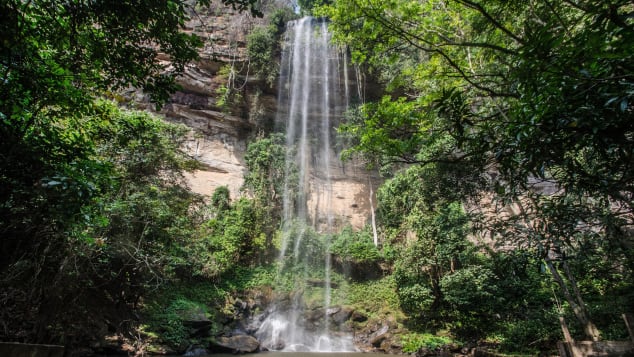 Powerful rivers flow through the forests of Fouta Djallon. Tommy Trenchard / Alamy Stock Photo
Just next door to Sierra Leone is Guinea, whose wildly scenic highlands are among west Africa's most spectacular places to hike.
Powerful rivers flow from the forests of Fouta Djallon, where an afternoon snack can mean plucking an avocado or mango from a nearby tree.
Join a Pular-speaking guide for a memorable trek through the rocky landscape for the chance to meet local people as you spend each night in a highland village. You'll be rewarded with rain-flush waterfalls, sharp canyons and a memorable taste of Guinean hospitality.
Why go: Tone your quads on a culture-bridging hike through the mountains.
International tourist arrivals in 2016: 60,000
Powerful rivers flow through the forests of Fouta Djallon. Tommy Trenchard / Alamy Stock Photo
Just next door to Sierra Leone is Guinea, whose wildly scenic highlands are among west Africa's most spectacular places to hike.
Powerful rivers flow from the forests of Fouta Djallon, where an afternoon snack can mean plucking an avocado or mango from a nearby tree.
Join a Pular-speaking guide for a memorable trek through the rocky landscape for the chance to meet local people as you spend each night in a highland village. You'll be rewarded with rain-flush waterfalls, sharp canyons and a memorable taste of Guinean hospitality.
Why go: Tone your quads on a culture-bridging hike through the mountains.
International tourist arrivals in 2016: 60,000
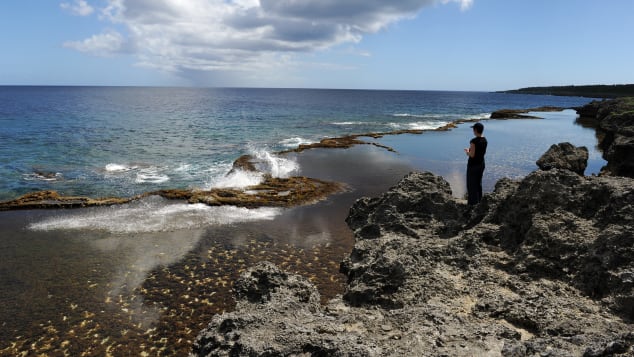 Tonga is famous for its hospitality.
Torsten Blackwood/AFP/Getty Images
Traditional feasts and fluttery palms set the scene in the Kingdom of Tonga, a South Pacific island group where travelers are treated to laid-back hospitality.
There are hidden beaches to explore here, as well as trees filled with flying foxes and islands that can be reached only by slow boat. While Tonga can lull travelers into a tropical reverie, the coast is downright explosive.
Hollow channels in the sharp volcanic rock create spectacular blowholes on the island of Tongatapu, where crashing waves shoot seawater hundreds of feet into the air -- it's a natural show worth traveling for.
Why go: Watch the ocean erupt from the rocky Tongan coast.
International tourist arrivals in 2017: 62,000
Read about the very best South Pacific islands to visit.
Tonga is famous for its hospitality.
Torsten Blackwood/AFP/Getty Images
Traditional feasts and fluttery palms set the scene in the Kingdom of Tonga, a South Pacific island group where travelers are treated to laid-back hospitality.
There are hidden beaches to explore here, as well as trees filled with flying foxes and islands that can be reached only by slow boat. While Tonga can lull travelers into a tropical reverie, the coast is downright explosive.
Hollow channels in the sharp volcanic rock create spectacular blowholes on the island of Tongatapu, where crashing waves shoot seawater hundreds of feet into the air -- it's a natural show worth traveling for.
Why go: Watch the ocean erupt from the rocky Tongan coast.
International tourist arrivals in 2017: 62,000
Read about the very best South Pacific islands to visit.
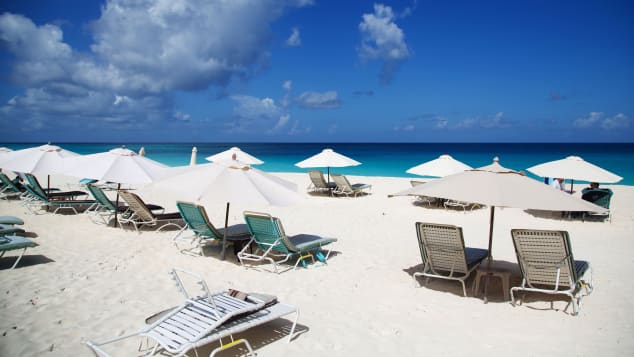 By limiting tourism to high end resorts, Anguilla has avoided over-development.
Cedrick Isham Calvados/AFP/Getty Images
Ringed in pale sand and topaz inlets, the British overseas territory of Anguilla has some of the Caribbean's finest beaches, but there's one thing that's notably absent -- other people.
By limiting tourism to high-end resorts, this island escape has dodged the intense development of neighboring islands. If you're flush enough to pay the high prices here, that means access to wonderfully uncrowded beaches.
There are 33 to choose from, but Rendezvous Bay is a gorgeous place to start. A handful of bright-painted beach bars are scattered along the beach, inviting repeated cocktail breaks as you stroll along the nearly 3-mile shoreline.
Why go: Experience high-end Caribbean cool with plenty of room to relax.
International tourist arrivals in 2017: 68,000
Read about the world's most beautiful island hotels -- including one on Anguilla.
By limiting tourism to high end resorts, Anguilla has avoided over-development.
Cedrick Isham Calvados/AFP/Getty Images
Ringed in pale sand and topaz inlets, the British overseas territory of Anguilla has some of the Caribbean's finest beaches, but there's one thing that's notably absent -- other people.
By limiting tourism to high-end resorts, this island escape has dodged the intense development of neighboring islands. If you're flush enough to pay the high prices here, that means access to wonderfully uncrowded beaches.
There are 33 to choose from, but Rendezvous Bay is a gorgeous place to start. A handful of bright-painted beach bars are scattered along the beach, inviting repeated cocktail breaks as you stroll along the nearly 3-mile shoreline.
Why go: Experience high-end Caribbean cool with plenty of room to relax.
International tourist arrivals in 2017: 68,000
Read about the world's most beautiful island hotels -- including one on Anguilla.
 East Timor hosts an annual mountain bike stage race.
STR/AFP/Getty Images
Better known to aid workers than tourists, Timor Leste had a chaotic few decades as it emerged as Asia's newest country.
Now, the mountains that once provided shelter for Timorese resistance fighters are being put to use as a testing ground for the super fit. The Tour de Timor, a 5-day mountain bike stage race, follows dirt tracks through the lush wilderness, tackles sustained climbs and passes through remote villages. It's earned a reputation as both a grueling challenge and a rewarding experience.
Not that you need to be a competitive athlete to go cycling in Timor Leste. If you don't mind the hills and the heat, bring your own bike here to pedal remote mountain roads with little car traffic.
Why go: Challenge yourself to the ride of a lifetime.
International tourist arrivals in 2017: 74,000
East Timor hosts an annual mountain bike stage race.
STR/AFP/Getty Images
Better known to aid workers than tourists, Timor Leste had a chaotic few decades as it emerged as Asia's newest country.
Now, the mountains that once provided shelter for Timorese resistance fighters are being put to use as a testing ground for the super fit. The Tour de Timor, a 5-day mountain bike stage race, follows dirt tracks through the lush wilderness, tackles sustained climbs and passes through remote villages. It's earned a reputation as both a grueling challenge and a rewarding experience.
Not that you need to be a competitive athlete to go cycling in Timor Leste. If you don't mind the hills and the heat, bring your own bike here to pedal remote mountain roads with little car traffic.
Why go: Challenge yourself to the ride of a lifetime.
International tourist arrivals in 2017: 74,000
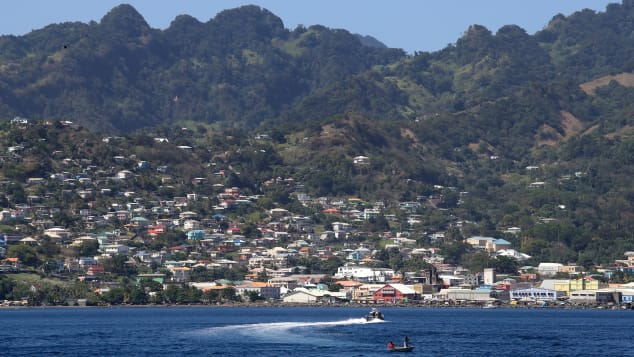 These islands attract the wealthy, but have budget-friendly options.
Chris Jackson/Getty Images
Since it took until 2017 for an international airport to open on St. Vincent and the Grenadines, the Caribbean island chain has long been the territory of salty cruisers and private yacht owners.
Use the public ferries, however, and you'll be island-hopping with a crowd that's more local than leisure-travel.
Catch the boat from St. Vincent to Union, and call at ports in Bequia, Canouan and Mayreau along the way. If you can afford a night at Canouan's top-shelf resorts, head to shore here to explore pristine barrier reefs.
Otherwise, continue to budget-friendly Union for sunset rum punch at Happy Island, a bar built atop a conch shell foundation just off the coast.
Why go: String together a necklace of islands with pearl-colored beaches.
International tourist arrivals in 2017: 76,000
Read about a private island retreat in St. Vincent.
These islands attract the wealthy, but have budget-friendly options.
Chris Jackson/Getty Images
Since it took until 2017 for an international airport to open on St. Vincent and the Grenadines, the Caribbean island chain has long been the territory of salty cruisers and private yacht owners.
Use the public ferries, however, and you'll be island-hopping with a crowd that's more local than leisure-travel.
Catch the boat from St. Vincent to Union, and call at ports in Bequia, Canouan and Mayreau along the way. If you can afford a night at Canouan's top-shelf resorts, head to shore here to explore pristine barrier reefs.
Otherwise, continue to budget-friendly Union for sunset rum punch at Happy Island, a bar built atop a conch shell foundation just off the coast.
Why go: String together a necklace of islands with pearl-colored beaches.
International tourist arrivals in 2017: 76,000
Read about a private island retreat in St. Vincent.
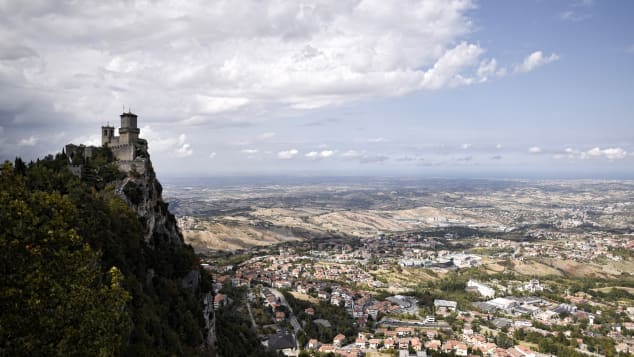 San Marino is surrounded by Italian territory.
Marco Bertorello/AFP/Getty Images
Surrounded by Italian territory on every side, the Republic of San Marino is 24 square miles of stubborn holdout. Established in the year 301, the sole remaining Italian city state is also the world's oldest surviving republic.
While the three historic towers that adorn the San Marino flag are now largely ornamental, they still keep watch over the mountainous countryside.
For views that stretch from border to border, climb to the picturesque Rocca Guaita, an 11th-century tower that fortifies an already-forbidding summit -- over the centuries it's helped fend off invaders, housed the national guard and even served as a prison.
Why go: Explore a mountaintop fortress in Europe's least-visited country.
International tourist arrivals in 2017: 78,000
Read about some of the world's quirkiest micronations.
San Marino is surrounded by Italian territory.
Marco Bertorello/AFP/Getty Images
Surrounded by Italian territory on every side, the Republic of San Marino is 24 square miles of stubborn holdout. Established in the year 301, the sole remaining Italian city state is also the world's oldest surviving republic.
While the three historic towers that adorn the San Marino flag are now largely ornamental, they still keep watch over the mountainous countryside.
For views that stretch from border to border, climb to the picturesque Rocca Guaita, an 11th-century tower that fortifies an already-forbidding summit -- over the centuries it's helped fend off invaders, housed the national guard and even served as a prison.
Why go: Explore a mountaintop fortress in Europe's least-visited country.
International tourist arrivals in 2017: 78,000
Read about some of the world's quirkiest micronations.
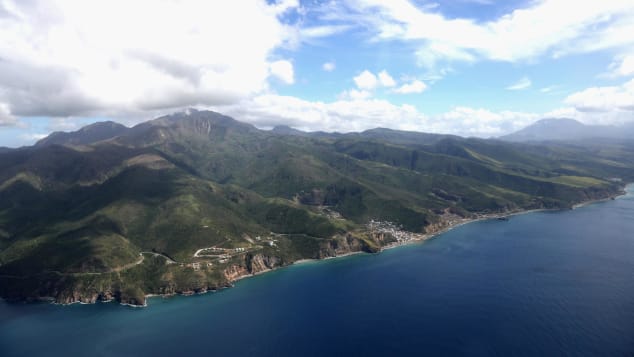 Dominica has the Caribbean's first-ever long distance hiking trail.
Chris Jackson/Getty Images
Nine active volcanoes are simmering beneath humid jungle in Dominica, with belching fumaroles and steaming hot springs to remind visitors of their seismic power.
And since 2010, the island's volcanic landscape has drawn adventurous travelers to the Caribbean's first-ever long distance hiking trail: The Waitukubuli National Trail crosses 115 miles of steep, muddy terrain as it traces a line from coast to coast.
It's a serious trek that turns the typical Caribbean vacation on its head, and you don't even need to carry a tent -- drift away after a day of hiking in the breezy comfort of a hammock.
Why go: Hike a section of the first long-distance trail in the Caribbean.
International tourist arrivals in 2017: 79,000
Read about the most overlooked islands in the world—and why Dominica is one of them.
Dominica has the Caribbean's first-ever long distance hiking trail.
Chris Jackson/Getty Images
Nine active volcanoes are simmering beneath humid jungle in Dominica, with belching fumaroles and steaming hot springs to remind visitors of their seismic power.
And since 2010, the island's volcanic landscape has drawn adventurous travelers to the Caribbean's first-ever long distance hiking trail: The Waitukubuli National Trail crosses 115 miles of steep, muddy terrain as it traces a line from coast to coast.
It's a serious trek that turns the typical Caribbean vacation on its head, and you don't even need to carry a tent -- drift away after a day of hiking in the breezy comfort of a hammock.
Why go: Hike a section of the first long-distance trail in the Caribbean.
International tourist arrivals in 2017: 79,000
Read about the most overlooked islands in the world—and why Dominica is one of them.
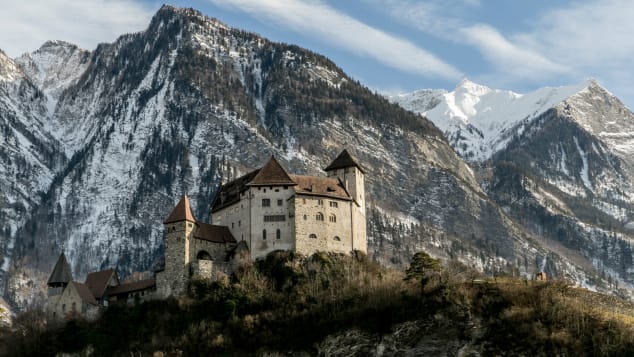 Historic castles keep watch over Liechtenstein.
Jan Hetfleisch/Getty Images
With an Alpine perch between Austria and Switzerland, the Principality of Liechtenstein is one of two doubly landlocked countries on earth -- that's a landlocked nation surrounded only by landlocked nations. (The other one is Uzbekistan.)
No one seems to mind the lack of a seacoast. Here, hiking trails navigate between stony peaks, while vineyards lap steep hillsides.
Historic castles keep watch over it all. To visit the country's most dramatic stronghold, travel to the village of Balzers, where you can set out on foot for Gutenberg Castle.
Visitors can linger in the castle rose garden, which fills with princess-pink blooms during the summer months.
Why go: Visit a fairy-tale castle in a mountain kingdom.
International tourist arrivals in 2017: 79,000
Historic castles keep watch over Liechtenstein.
Jan Hetfleisch/Getty Images
With an Alpine perch between Austria and Switzerland, the Principality of Liechtenstein is one of two doubly landlocked countries on earth -- that's a landlocked nation surrounded only by landlocked nations. (The other one is Uzbekistan.)
No one seems to mind the lack of a seacoast. Here, hiking trails navigate between stony peaks, while vineyards lap steep hillsides.
Historic castles keep watch over it all. To visit the country's most dramatic stronghold, travel to the village of Balzers, where you can set out on foot for Gutenberg Castle.
Visitors can linger in the castle rose garden, which fills with princess-pink blooms during the summer months.
Why go: Visit a fairy-tale castle in a mountain kingdom.
International tourist arrivals in 2017: 79,000
 East Tanna's Mount Yasur volcano is among the world's most active.
Thierry Suzan/Figarophoto/Redux/Figarophoto/Thierry Suzan/Figarophoto/Redux
The few tourists that venture this deep into the South Pacific will be rewarded with the kind of island scenery people use as desktop images -- think white sand, palm trees and crystalline water.
But there's a hint of danger in the paradise landscape. East Tanna's Mount Yasur volcano is among the world's most active, with a pyrotechnic display of lava and sparks that keeps visitors at a distance.
And on beautiful Pentecost Island, daring locals practice a tradition called Nagol, or land diving. Come here for the Saturday festivals from April through June to see men and boys scaling wooden towers up to 100 feet high, then leaping into space with vines secured to their ankles.
The rite celebrates the yam harvest and male fertility.
Why go: Watch daredevil "land divers" practice the original extreme sport.
International tourist arrivals in 2017: 109,000
East Tanna's Mount Yasur volcano is among the world's most active.
Thierry Suzan/Figarophoto/Redux/Figarophoto/Thierry Suzan/Figarophoto/Redux
The few tourists that venture this deep into the South Pacific will be rewarded with the kind of island scenery people use as desktop images -- think white sand, palm trees and crystalline water.
But there's a hint of danger in the paradise landscape. East Tanna's Mount Yasur volcano is among the world's most active, with a pyrotechnic display of lava and sparks that keeps visitors at a distance.
And on beautiful Pentecost Island, daring locals practice a tradition called Nagol, or land diving. Come here for the Saturday festivals from April through June to see men and boys scaling wooden towers up to 100 feet high, then leaping into space with vines secured to their ankles.
The rite celebrates the yam harvest and male fertility.
Why go: Watch daredevil "land divers" practice the original extreme sport.
International tourist arrivals in 2017: 109,000
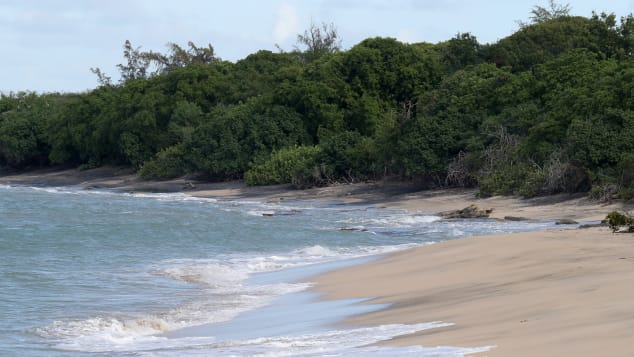 The islands of St. Kitts and Nevis enjoy a slower pace of life.
Chris Jackson/Getty Images
A pair of islands with a dreamy Caribbean landscape, St. Kitts and Nevis have magnificent beaches and a laid-back spirit.
Of the two, Nevis is more remote. This is where Alexander Hamilton was born -- his birthplace is the modern-day site of the Nevis Historical Society -- but not even Hamilton mania has robbed the isolated island of its castaway feel.
That slow pace of life invites lingering over the island's distinctive cuisine. After trying the local specialty of goat water stew, enjoy ultra-fresh seafood and plenty of island-grown fruit.
Don't forget to finish your feast with a generous pour of aged, spiced rum.
Why go: Taste Caribbean cuisine that's fresh from the garden and sea.
International tourist arrivals in 2017: 114,000
Read about what to do in St Kitts and Nevis and about finding Alexander Hamilton there.
The islands of St. Kitts and Nevis enjoy a slower pace of life.
Chris Jackson/Getty Images
A pair of islands with a dreamy Caribbean landscape, St. Kitts and Nevis have magnificent beaches and a laid-back spirit.
Of the two, Nevis is more remote. This is where Alexander Hamilton was born -- his birthplace is the modern-day site of the Nevis Historical Society -- but not even Hamilton mania has robbed the isolated island of its castaway feel.
That slow pace of life invites lingering over the island's distinctive cuisine. After trying the local specialty of goat water stew, enjoy ultra-fresh seafood and plenty of island-grown fruit.
Don't forget to finish your feast with a generous pour of aged, spiced rum.
Why go: Taste Caribbean cuisine that's fresh from the garden and sea.
International tourist arrivals in 2017: 114,000
Read about what to do in St Kitts and Nevis and about finding Alexander Hamilton there.
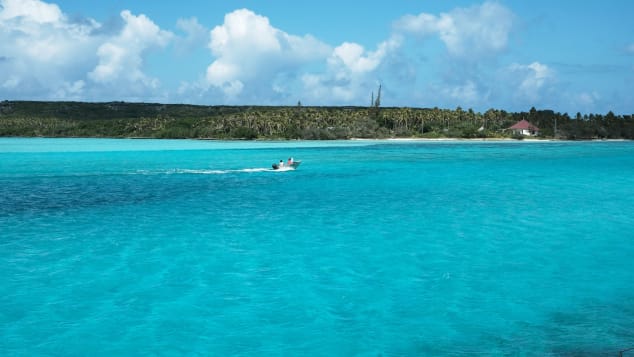 New Caledonia's waters are a haven for marine life.
Theo Rouby/AFP/Getty Images
Whether you're sailing, snorkeling or just swimming off the beach, New Caledonia's lagoons are magnificent.
Look closer to find remarkable diversity. Dozens of species of sharks have been spotted here, along with sea turtles and big fish. The gentle dugong -- a relative of the manatee -- lives in the shallow coastal waters, while fish explore the world's third-largest reef system.
And 95% of New Caledonia's waters are protected, creating a haven for marine life that's a dream destination for nature-loving travelers.
Compared with the more remote Pacific islands, New Caledonia is a breeze to reach on flights from New Zealand and Australia. The French overseas territory's capital of Noumea, which is more than 10,000 miles from Paris, is just 914 miles from the Australian city of Brisbane.
Why go: Loll in New Caledonia lagoons with a mellow herd of dugong.
International tourist arrivals in 2017: 121,000
Read more about New Caledonia's magnificent marine park.
New Caledonia's waters are a haven for marine life.
Theo Rouby/AFP/Getty Images
Whether you're sailing, snorkeling or just swimming off the beach, New Caledonia's lagoons are magnificent.
Look closer to find remarkable diversity. Dozens of species of sharks have been spotted here, along with sea turtles and big fish. The gentle dugong -- a relative of the manatee -- lives in the shallow coastal waters, while fish explore the world's third-largest reef system.
And 95% of New Caledonia's waters are protected, creating a haven for marine life that's a dream destination for nature-loving travelers.
Compared with the more remote Pacific islands, New Caledonia is a breeze to reach on flights from New Zealand and Australia. The French overseas territory's capital of Noumea, which is more than 10,000 miles from Paris, is just 914 miles from the Australian city of Brisbane.
Why go: Loll in New Caledonia lagoons with a mellow herd of dugong.
International tourist arrivals in 2017: 121,000
Read more about New Caledonia's magnificent marine park.
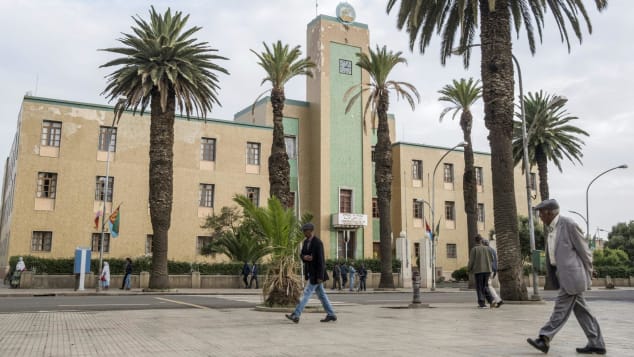 Eritrea's capital Asmara is a design-lover's dream.
Maheder Haileselassie/AFP/Getty Images
With scenery that rolls from arid hills to the Red Sea coast, Eritrea's natural beauty has been the backdrop for a tumultuous history. While some parts of the this east African country remain risky -- the UK recommends avoiding the land borders -- there's much to tempt travelers here.
World-class scuba diving, wonderfully diverse cultures and traditional foods are highlights of visiting the country, while the capital of Asmara is a pilgrimage place for fans of Modernist architecture.
Up in the cool air of a highland plateau, the city has a remarkable collection of preserved buildings from 1893 to 1941, a period when Italy was occupying the country.
From vintage cinemas to Futurist masterpieces, Asmara is a design-lover's dream, and it's Eritrea's first spot on the list of UNESCO World Heritage Sites.
Why go: Discover Modernist architecture in Asmara, a UNESCO World Heritage Site.
International tourist arrivals in 2016: 142,000
Read more about Asmara architecture.
Eritrea's capital Asmara is a design-lover's dream.
Maheder Haileselassie/AFP/Getty Images
With scenery that rolls from arid hills to the Red Sea coast, Eritrea's natural beauty has been the backdrop for a tumultuous history. While some parts of the this east African country remain risky -- the UK recommends avoiding the land borders -- there's much to tempt travelers here.
World-class scuba diving, wonderfully diverse cultures and traditional foods are highlights of visiting the country, while the capital of Asmara is a pilgrimage place for fans of Modernist architecture.
Up in the cool air of a highland plateau, the city has a remarkable collection of preserved buildings from 1893 to 1941, a period when Italy was occupying the country.
From vintage cinemas to Futurist masterpieces, Asmara is a design-lover's dream, and it's Eritrea's first spot on the list of UNESCO World Heritage Sites.
Why go: Discover Modernist architecture in Asmara, a UNESCO World Heritage Site.
International tourist arrivals in 2016: 142,000
Read more about Asmara architecture.
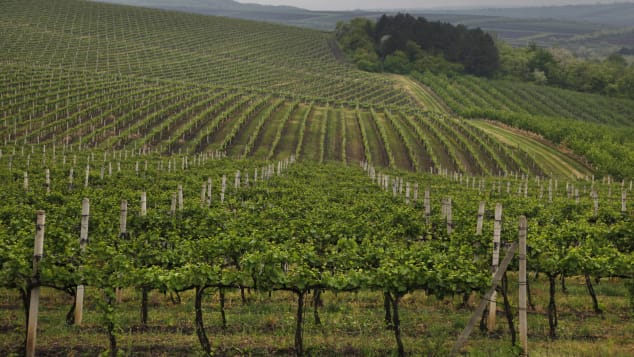 Moldova may be the poorest country in Eastern Europe, but it has an impressive viniculture.
Jen Osborne/Redux/Redux/Jen Osborne/Redux
Try to link up all the wine bars on a walk through Chisinau, the capital of Moldova, and you might find yourself in need of a glass of pickle juice. (That's the local hangover cure.)
While many western wine drinkers are unfamiliar with Moldovan vintages, the tiny Eastern European country is a heavy hitter, and wine has been made here for at least 5,000 years. Using a blend of Caucasian, European and local grapes, Moldovan vintners bottle everything from dry, velvety reds to dessert-friendly ice wines.
Attend the festivities for National Wine Day to try a little bit of everything with an enthusiastic crowd of locals.
Why go: Learn to say "noroc!" -- that's cheers -- over a glass of Moldovan wine.
International tourist arrivals in 2017: 145,000
Read about a record-setting, underground wine labyrinth in Moldova that houses Putin's personal bottles.
Moldova may be the poorest country in Eastern Europe, but it has an impressive viniculture.
Jen Osborne/Redux/Redux/Jen Osborne/Redux
Try to link up all the wine bars on a walk through Chisinau, the capital of Moldova, and you might find yourself in need of a glass of pickle juice. (That's the local hangover cure.)
While many western wine drinkers are unfamiliar with Moldovan vintages, the tiny Eastern European country is a heavy hitter, and wine has been made here for at least 5,000 years. Using a blend of Caucasian, European and local grapes, Moldovan vintners bottle everything from dry, velvety reds to dessert-friendly ice wines.
Attend the festivities for National Wine Day to try a little bit of everything with an enthusiastic crowd of locals.
Why go: Learn to say "noroc!" -- that's cheers -- over a glass of Moldovan wine.
International tourist arrivals in 2017: 145,000
Read about a record-setting, underground wine labyrinth in Moldova that houses Putin's personal bottles.
1. Tuvalu
 Tuvalu is among the world's most isolated nations. Fiona Goodall/Getty Images
With more than 100 tiny islands scattered across the South Pacific, the country of Tuvalu is among the world's most isolated nations.
Only the main island, Funafuti, has an airport. From there, travellers continue to the outlying communities by passenger ferry. Free from the crowds that fill beaches in popular destinations like Fiji, these islands are an untouristed haven where you can watch flying fish skim the water, spend a lazy afternoon in a hammock or snorkel candy-hued coral reefs.
If you're planning a trip to Tuvalu, don't wait: The waves that lap Tuvalu's stilt houses have long been seen as an existential threat here, since rising seas could swamp the low-lying country.
Why go: Stroll powdered sugar beaches at risk from rising sea levels.
International tourist arrivals in 2017: 2,000
Tuvalu is among the world's most isolated nations. Fiona Goodall/Getty Images
With more than 100 tiny islands scattered across the South Pacific, the country of Tuvalu is among the world's most isolated nations.
Only the main island, Funafuti, has an airport. From there, travellers continue to the outlying communities by passenger ferry. Free from the crowds that fill beaches in popular destinations like Fiji, these islands are an untouristed haven where you can watch flying fish skim the water, spend a lazy afternoon in a hammock or snorkel candy-hued coral reefs.
If you're planning a trip to Tuvalu, don't wait: The waves that lap Tuvalu's stilt houses have long been seen as an existential threat here, since rising seas could swamp the low-lying country.
Why go: Stroll powdered sugar beaches at risk from rising sea levels.
International tourist arrivals in 2017: 2,000
2. Kiribati
 Kiribati's beauty is matched by its remoteness.
The AGE/Fairfax Media/Fairfax Media via Getty Images
Scatter-shot atolls and lagoons barely peek above the central Pacific waters in Kiribati, whose islands and atolls cluster into three groups: the Gilbert, Phoenix and Line Islands.
It's hard to overstate the isolation of these faraway isles -- neighbouring Fiji is relatively close at 1,394 miles away -- and few travelers make the journey here. Those that do, however, will be treated to a rich tradition of hospitality. While not every visitor will secure an invitation to a traditional feast, or botaki, many have.
If you're lucky enough to attend, you might see dancers in pandanus skirts, listen to drums beating out a traditional rhythm then dine on breadfruit, taro and sprouted coconut.
Why go: Experience a botaki in an open-air maneaba, or meeting house.
International tourist arrivals in 2016: 6,000
Read about why Kiribati celebrates the new year earlier than almost anyone else.
Kiribati's beauty is matched by its remoteness.
The AGE/Fairfax Media/Fairfax Media via Getty Images
Scatter-shot atolls and lagoons barely peek above the central Pacific waters in Kiribati, whose islands and atolls cluster into three groups: the Gilbert, Phoenix and Line Islands.
It's hard to overstate the isolation of these faraway isles -- neighbouring Fiji is relatively close at 1,394 miles away -- and few travelers make the journey here. Those that do, however, will be treated to a rich tradition of hospitality. While not every visitor will secure an invitation to a traditional feast, or botaki, many have.
If you're lucky enough to attend, you might see dancers in pandanus skirts, listen to drums beating out a traditional rhythm then dine on breadfruit, taro and sprouted coconut.
Why go: Experience a botaki in an open-air maneaba, or meeting house.
International tourist arrivals in 2016: 6,000
Read about why Kiribati celebrates the new year earlier than almost anyone else.
3. Marshall Islands
 The waters around the Marshall Islands are home to spectacular scuba diving sites. Reinhard Dirscherl/ullstein bild/Getty Images
Bombs and bathing suits put these Pacific isles on the world's radar -- bikinis were named for the United States' nuclear testing on the Marshall Islands' Bikini Atoll.
Decades later the island is still radioactive, as is the test site at Enewetak Atoll, but the waters surrounding Bikini Atoll have become one of the world's most spectacular scuba diving sites.
There are more than a dozen shipwrecks on the seafloor near Bikini Atoll. Make your first dive to see the aircraft carrier USS Saratoga, which was present at the Battle of Iwo Jima before the US military used the ship for nuclear target practice. Divers will find deck guns blooming into colorful coral reefs, and schools of fish threading between bombs still strapped to the ship's metal decks.
Why go: Scuba dive into a ship graveyard transformed into an eerie underwater playground.
International tourist arrivals in 2017: 6,000
Follow an interactive journey to the Marshall Islands.
The waters around the Marshall Islands are home to spectacular scuba diving sites. Reinhard Dirscherl/ullstein bild/Getty Images
Bombs and bathing suits put these Pacific isles on the world's radar -- bikinis were named for the United States' nuclear testing on the Marshall Islands' Bikini Atoll.
Decades later the island is still radioactive, as is the test site at Enewetak Atoll, but the waters surrounding Bikini Atoll have become one of the world's most spectacular scuba diving sites.
There are more than a dozen shipwrecks on the seafloor near Bikini Atoll. Make your first dive to see the aircraft carrier USS Saratoga, which was present at the Battle of Iwo Jima before the US military used the ship for nuclear target practice. Divers will find deck guns blooming into colorful coral reefs, and schools of fish threading between bombs still strapped to the ship's metal decks.
Why go: Scuba dive into a ship graveyard transformed into an eerie underwater playground.
International tourist arrivals in 2017: 6,000
Follow an interactive journey to the Marshall Islands.
4. Montserrat
 Montesrrat's landscape is shaped by volcanoes. Sebastian Widmann/dpa/AP
Velvety green hills pinch towards the rim of Montserrat's Soufrière Hills volcano, whose incendiary force has shaped the landscape of this Caribbean island.
Much of Montserrat was overshadowed by volcanic eruptions in the 1990s, when the capital city of Plymouth was buried under a deep layer of ash and volcanic stone. Now, visitors come by plane or ferry from the nearby island of Antigua to see the fallout of the volcano's furious power.
Tours of Plymouth reveal a 17th-century church turned gray with ash and the ruins of a once-grand hotel.
Why go: See a modern-day Pompeii, then lounge on new beaches created from crumbling volcanic stone.
International tourist arrivals in 2017: 8,000
Montesrrat's landscape is shaped by volcanoes. Sebastian Widmann/dpa/AP
Velvety green hills pinch towards the rim of Montserrat's Soufrière Hills volcano, whose incendiary force has shaped the landscape of this Caribbean island.
Much of Montserrat was overshadowed by volcanic eruptions in the 1990s, when the capital city of Plymouth was buried under a deep layer of ash and volcanic stone. Now, visitors come by plane or ferry from the nearby island of Antigua to see the fallout of the volcano's furious power.
Tours of Plymouth reveal a 17th-century church turned gray with ash and the ruins of a once-grand hotel.
Why go: See a modern-day Pompeii, then lounge on new beaches created from crumbling volcanic stone.
International tourist arrivals in 2017: 8,000
5. Niue
 The waters off Niue's rugged coastline are used as a nursery by humpback whales. Nick Perry/AP
If your image of a Polynesian island is all gentle waves and soft sand, think again: Niue's rugged and cave-pocked coast is etched in sharp coral.
From July through October, humpback whales use Niue as a warm-water nursery, lolling close enough to the island to be spotted from shore. During those months, the sound of the whales' songs and slapping tails can be heard above the sea breeze.
Here, visitors can even join trained guides to swim with the humpback whales, one of the few places on earth where it's possible.
Why go: Swim alongside school bus-sized whales in one of the world's smallest countries.
International tourist arrivals in 2017: 10,000
The waters off Niue's rugged coastline are used as a nursery by humpback whales. Nick Perry/AP
If your image of a Polynesian island is all gentle waves and soft sand, think again: Niue's rugged and cave-pocked coast is etched in sharp coral.
From July through October, humpback whales use Niue as a warm-water nursery, lolling close enough to the island to be spotted from shore. During those months, the sound of the whales' songs and slapping tails can be heard above the sea breeze.
Here, visitors can even join trained guides to swim with the humpback whales, one of the few places on earth where it's possible.
Why go: Swim alongside school bus-sized whales in one of the world's smallest countries.
International tourist arrivals in 2017: 10,000
6. American Samoa
 Matafao Peak dominates the skyline above Pago Pago Harbour. Torsten Blackwood/AFP/Getty Images
Steeply pitched islands drop towards crystalline water in American Samoa, a South Pacific island group northeast of Fiji that's the only US territory in the Southern Hemisphere.
Whether you're skimming Pago Pago Harbor in an outrigger canoe or casting a line for hefty tuna and marlin, there are endless ways to explore the sea here. To find the treasures hidden in the dense forest canopy, head to the National Park of American Samoa for a trek through fruit bat country.
The Samoan fruit bat has a wingspan of up to three feet, and the fuzzy mammals can be spotted dangling from trees or swooping through the air in search of fresh fruit and nectar.
Why go: Hang with the endangered fruit bats of the National Park of American Samoa.
International tourist arrivals in 2017: 20,000
Matafao Peak dominates the skyline above Pago Pago Harbour. Torsten Blackwood/AFP/Getty Images
Steeply pitched islands drop towards crystalline water in American Samoa, a South Pacific island group northeast of Fiji that's the only US territory in the Southern Hemisphere.
Whether you're skimming Pago Pago Harbor in an outrigger canoe or casting a line for hefty tuna and marlin, there are endless ways to explore the sea here. To find the treasures hidden in the dense forest canopy, head to the National Park of American Samoa for a trek through fruit bat country.
The Samoan fruit bat has a wingspan of up to three feet, and the fuzzy mammals can be spotted dangling from trees or swooping through the air in search of fresh fruit and nectar.
Why go: Hang with the endangered fruit bats of the National Park of American Samoa.
International tourist arrivals in 2017: 20,000
7. Solomon Islands
 Sunken seaplanes, oil tankers and submarines make the Solomon Islands a subaquatic museum. Prisma by Dukas/Universal Images Group Editorial/UIG via Getty Images
Desperate battles unfolded against a paradise-island backdrop in this South Pacific archipelago after US Marines landed on Guadalcanal Island in 1942.
Decades after the last skirmish, the lush jungle holds rusting tanks, amphibious vehicles and fox holes that are a haunting reminder of that era. And the history doesn't stop at the waterline.
Sunken seaplanes, oil tankers and submarines are strewn across the ocean floor, sprouting coral formations on corroded metal sheathings. For travelers who snorkel or scuba dive, exploring the Solomon Islands is the chance to watch sea life colonize the remnants of a brutal war.
Why go: Discover Second World War history in a vast archipelago.
International tourist arrivals in 2017: 26,000
Read about the best private islands on earth -- including one in the Solomon Islands.
Sunken seaplanes, oil tankers and submarines make the Solomon Islands a subaquatic museum. Prisma by Dukas/Universal Images Group Editorial/UIG via Getty Images
Desperate battles unfolded against a paradise-island backdrop in this South Pacific archipelago after US Marines landed on Guadalcanal Island in 1942.
Decades after the last skirmish, the lush jungle holds rusting tanks, amphibious vehicles and fox holes that are a haunting reminder of that era. And the history doesn't stop at the waterline.
Sunken seaplanes, oil tankers and submarines are strewn across the ocean floor, sprouting coral formations on corroded metal sheathings. For travelers who snorkel or scuba dive, exploring the Solomon Islands is the chance to watch sea life colonize the remnants of a brutal war.
Why go: Discover Second World War history in a vast archipelago.
International tourist arrivals in 2017: 26,000
Read about the best private islands on earth -- including one in the Solomon Islands.
8. Comoros
 The islands of Comoros are often called the "Perfume Isles." Tony Karumba/AFP/Getty Images
Cupped in the ocean between Madagascar and Mozambique, Comoros has the kind of clear water and pale beaches that draw travelers to the Seychelles -- but with few tourists and little development.
There's something in the air here, too. Often called the "Perfume Isles," the islands of Comoros have been cultivating aromatic plants for making scents since the French colonial era.
Now, the blossoms of the ylang-ylang tree infuse the breeze with an evocative aroma, mixing with cloves, bergamot, jasmine, vanilla and lemongrass to intoxicating effect.
Why go: Breathe the perfumed air of an island that overflows with blooms.
International tourist arrivals in 2017: 28,000
Need more reasons to visit Comoros? Here are five.
The islands of Comoros are often called the "Perfume Isles." Tony Karumba/AFP/Getty Images
Cupped in the ocean between Madagascar and Mozambique, Comoros has the kind of clear water and pale beaches that draw travelers to the Seychelles -- but with few tourists and little development.
There's something in the air here, too. Often called the "Perfume Isles," the islands of Comoros have been cultivating aromatic plants for making scents since the French colonial era.
Now, the blossoms of the ylang-ylang tree infuse the breeze with an evocative aroma, mixing with cloves, bergamot, jasmine, vanilla and lemongrass to intoxicating effect.
Why go: Breathe the perfumed air of an island that overflows with blooms.
International tourist arrivals in 2017: 28,000
Need more reasons to visit Comoros? Here are five.
9. São Tomé and Príncipe
 São Tomé and Principe are a biodiversity hotspot. Ruth McDowall/AFP/Getty Images
Making up a nearly equatorial nation in west Africa's Gulf of Guinea, the islands of São Tomé and Príncipe are packed with endemic plants and animals.
In the lush jungle that has overtaken former coffee plantations here, travelers might find begonias growing high as a house, hundreds of orchid species and birds in every hue.
For a nature-lover's introduction to this biodiversity hotspot, start by flying into the main island of São Tomé then continue by small plane to tiny Príncipe. The volcanic island is a UNESCO Biosphere Reserve, and new species are discovered here on a regular basis, from reed frogs to owls.
Peer carefully into the foliage, and you may spot a blooming flower or furtive creature that's yet to be documented by scientists.
Why go: Search for undiscovered species in a biodiversity hot spot.
International tourist arrivals in 2016: 29,000
São Tomé and Principe are a biodiversity hotspot. Ruth McDowall/AFP/Getty Images
Making up a nearly equatorial nation in west Africa's Gulf of Guinea, the islands of São Tomé and Príncipe are packed with endemic plants and animals.
In the lush jungle that has overtaken former coffee plantations here, travelers might find begonias growing high as a house, hundreds of orchid species and birds in every hue.
For a nature-lover's introduction to this biodiversity hotspot, start by flying into the main island of São Tomé then continue by small plane to tiny Príncipe. The volcanic island is a UNESCO Biosphere Reserve, and new species are discovered here on a regular basis, from reed frogs to owls.
Peer carefully into the foliage, and you may spot a blooming flower or furtive creature that's yet to be documented by scientists.
Why go: Search for undiscovered species in a biodiversity hot spot.
International tourist arrivals in 2016: 29,000
10. Federated States of Micronesia
 The ancient city of Nan Madol is home to grand basalt palaces and temples. Nicole Evatt/AP
If you plan to spend one day on every island in the Federated States of Micronesia (FSM), you'll need more than a year and a half to explore the Pacific nation. There are 607 islands here, but put them together and they add up to a mere 271 square miles of land -- and that's spread across nearly 2.6 million square miles of water.
Many of the islands are uninhabited. But exploring Pohnpei, the largest island in the FSM, is a fascinating reminder that the archipelago's been shaped by humans for centuries.
Off the island's southeastern coast is the UNESCO World Heritage Site of Nan Madol, which comprises 100 man-made islets created by a great Pacific dynasty. Here, travelers can explore grand basalt palaces and temples constructed at the center's apex between 1,200 and 1,500 AD.
Why go: Visit an ancient ceremonial center rising from the ocean.
International tourist arrivals in 2016: 30,000
Read about how Nan Madol inspired the horror writer H.P. Lovecraft.
The ancient city of Nan Madol is home to grand basalt palaces and temples. Nicole Evatt/AP
If you plan to spend one day on every island in the Federated States of Micronesia (FSM), you'll need more than a year and a half to explore the Pacific nation. There are 607 islands here, but put them together and they add up to a mere 271 square miles of land -- and that's spread across nearly 2.6 million square miles of water.
Many of the islands are uninhabited. But exploring Pohnpei, the largest island in the FSM, is a fascinating reminder that the archipelago's been shaped by humans for centuries.
Off the island's southeastern coast is the UNESCO World Heritage Site of Nan Madol, which comprises 100 man-made islets created by a great Pacific dynasty. Here, travelers can explore grand basalt palaces and temples constructed at the center's apex between 1,200 and 1,500 AD.
Why go: Visit an ancient ceremonial center rising from the ocean.
International tourist arrivals in 2016: 30,000
Read about how Nan Madol inspired the horror writer H.P. Lovecraft.
11. Djibouti
 Djibouti's landscape can seem otherworldy.
South China Morning Post/South China Morning Post/South China Morning Post via Get
Perched at the confluence of the Red Sea and the Gulf of Aden, Djibouti has a strategic location -- but the landscape itself can seem otherworldly.
White-salt beaches ring the hyper-saline Lake Assal, steam pours from the Ardoukoba Volcano and camels graze amidst lunar towers in Lake Abbé.
There, travelers can spot bubble gum-colored flamingos that lend the otherwise desolate scene a rococo flourish. It's a testament to human ingenuity that the nomadic Afar people have carved a life in this harsh environment, leading their flocks to graze on widely scattered pockets of marsh grass.
Why go: Have an off-planet experience without the costly space flight.
International tourist arrivals in 2010: 51,000
Djibouti's landscape can seem otherworldy.
South China Morning Post/South China Morning Post/South China Morning Post via Get
Perched at the confluence of the Red Sea and the Gulf of Aden, Djibouti has a strategic location -- but the landscape itself can seem otherworldly.
White-salt beaches ring the hyper-saline Lake Assal, steam pours from the Ardoukoba Volcano and camels graze amidst lunar towers in Lake Abbé.
There, travelers can spot bubble gum-colored flamingos that lend the otherwise desolate scene a rococo flourish. It's a testament to human ingenuity that the nomadic Afar people have carved a life in this harsh environment, leading their flocks to graze on widely scattered pockets of marsh grass.
Why go: Have an off-planet experience without the costly space flight.
International tourist arrivals in 2010: 51,000
12. Sierra Leone
 Tokeh beach near Freetown has bone-white sand.
Issouf Sanogo/AFP/Getty Images
If thinking of Sierra Leone doesn't inspire daydreams of powdery beaches, surf breaks and nesting sea turtles, you might need an update.
From civil war to Ebola outbreaks, this west African country has faced hard knocks in recent decades, but that's one more reason to support the slowly recovering tourist economy.
Stake out a sunny piece of sand on the Western Peninsula, and you can sip a locally brewed Star Lager as you scan the waterline for sea turtles.
Why go: Picture-postcard beach vacations way off the tourist map. Did we mention there are pygmy hippos here?
International tourist arrivals in 2016: 54,000
Read about Africa's 25 best beaches -- including a white-sand stunner in Sierra Leone.
Tokeh beach near Freetown has bone-white sand.
Issouf Sanogo/AFP/Getty Images
If thinking of Sierra Leone doesn't inspire daydreams of powdery beaches, surf breaks and nesting sea turtles, you might need an update.
From civil war to Ebola outbreaks, this west African country has faced hard knocks in recent decades, but that's one more reason to support the slowly recovering tourist economy.
Stake out a sunny piece of sand on the Western Peninsula, and you can sip a locally brewed Star Lager as you scan the waterline for sea turtles.
Why go: Picture-postcard beach vacations way off the tourist map. Did we mention there are pygmy hippos here?
International tourist arrivals in 2016: 54,000
Read about Africa's 25 best beaches -- including a white-sand stunner in Sierra Leone.
13. Guinea
 Powerful rivers flow through the forests of Fouta Djallon. Tommy Trenchard / Alamy Stock Photo
Just next door to Sierra Leone is Guinea, whose wildly scenic highlands are among west Africa's most spectacular places to hike.
Powerful rivers flow from the forests of Fouta Djallon, where an afternoon snack can mean plucking an avocado or mango from a nearby tree.
Join a Pular-speaking guide for a memorable trek through the rocky landscape for the chance to meet local people as you spend each night in a highland village. You'll be rewarded with rain-flush waterfalls, sharp canyons and a memorable taste of Guinean hospitality.
Why go: Tone your quads on a culture-bridging hike through the mountains.
International tourist arrivals in 2016: 60,000
Powerful rivers flow through the forests of Fouta Djallon. Tommy Trenchard / Alamy Stock Photo
Just next door to Sierra Leone is Guinea, whose wildly scenic highlands are among west Africa's most spectacular places to hike.
Powerful rivers flow from the forests of Fouta Djallon, where an afternoon snack can mean plucking an avocado or mango from a nearby tree.
Join a Pular-speaking guide for a memorable trek through the rocky landscape for the chance to meet local people as you spend each night in a highland village. You'll be rewarded with rain-flush waterfalls, sharp canyons and a memorable taste of Guinean hospitality.
Why go: Tone your quads on a culture-bridging hike through the mountains.
International tourist arrivals in 2016: 60,000
14. Tonga
 Tonga is famous for its hospitality.
Torsten Blackwood/AFP/Getty Images
Traditional feasts and fluttery palms set the scene in the Kingdom of Tonga, a South Pacific island group where travelers are treated to laid-back hospitality.
There are hidden beaches to explore here, as well as trees filled with flying foxes and islands that can be reached only by slow boat. While Tonga can lull travelers into a tropical reverie, the coast is downright explosive.
Hollow channels in the sharp volcanic rock create spectacular blowholes on the island of Tongatapu, where crashing waves shoot seawater hundreds of feet into the air -- it's a natural show worth traveling for.
Why go: Watch the ocean erupt from the rocky Tongan coast.
International tourist arrivals in 2017: 62,000
Read about the very best South Pacific islands to visit.
Tonga is famous for its hospitality.
Torsten Blackwood/AFP/Getty Images
Traditional feasts and fluttery palms set the scene in the Kingdom of Tonga, a South Pacific island group where travelers are treated to laid-back hospitality.
There are hidden beaches to explore here, as well as trees filled with flying foxes and islands that can be reached only by slow boat. While Tonga can lull travelers into a tropical reverie, the coast is downright explosive.
Hollow channels in the sharp volcanic rock create spectacular blowholes on the island of Tongatapu, where crashing waves shoot seawater hundreds of feet into the air -- it's a natural show worth traveling for.
Why go: Watch the ocean erupt from the rocky Tongan coast.
International tourist arrivals in 2017: 62,000
Read about the very best South Pacific islands to visit.
15. Anguilla
 By limiting tourism to high end resorts, Anguilla has avoided over-development.
Cedrick Isham Calvados/AFP/Getty Images
Ringed in pale sand and topaz inlets, the British overseas territory of Anguilla has some of the Caribbean's finest beaches, but there's one thing that's notably absent -- other people.
By limiting tourism to high-end resorts, this island escape has dodged the intense development of neighboring islands. If you're flush enough to pay the high prices here, that means access to wonderfully uncrowded beaches.
There are 33 to choose from, but Rendezvous Bay is a gorgeous place to start. A handful of bright-painted beach bars are scattered along the beach, inviting repeated cocktail breaks as you stroll along the nearly 3-mile shoreline.
Why go: Experience high-end Caribbean cool with plenty of room to relax.
International tourist arrivals in 2017: 68,000
Read about the world's most beautiful island hotels -- including one on Anguilla.
By limiting tourism to high end resorts, Anguilla has avoided over-development.
Cedrick Isham Calvados/AFP/Getty Images
Ringed in pale sand and topaz inlets, the British overseas territory of Anguilla has some of the Caribbean's finest beaches, but there's one thing that's notably absent -- other people.
By limiting tourism to high-end resorts, this island escape has dodged the intense development of neighboring islands. If you're flush enough to pay the high prices here, that means access to wonderfully uncrowded beaches.
There are 33 to choose from, but Rendezvous Bay is a gorgeous place to start. A handful of bright-painted beach bars are scattered along the beach, inviting repeated cocktail breaks as you stroll along the nearly 3-mile shoreline.
Why go: Experience high-end Caribbean cool with plenty of room to relax.
International tourist arrivals in 2017: 68,000
Read about the world's most beautiful island hotels -- including one on Anguilla.
16. Timor Leste
 East Timor hosts an annual mountain bike stage race.
STR/AFP/Getty Images
Better known to aid workers than tourists, Timor Leste had a chaotic few decades as it emerged as Asia's newest country.
Now, the mountains that once provided shelter for Timorese resistance fighters are being put to use as a testing ground for the super fit. The Tour de Timor, a 5-day mountain bike stage race, follows dirt tracks through the lush wilderness, tackles sustained climbs and passes through remote villages. It's earned a reputation as both a grueling challenge and a rewarding experience.
Not that you need to be a competitive athlete to go cycling in Timor Leste. If you don't mind the hills and the heat, bring your own bike here to pedal remote mountain roads with little car traffic.
Why go: Challenge yourself to the ride of a lifetime.
International tourist arrivals in 2017: 74,000
East Timor hosts an annual mountain bike stage race.
STR/AFP/Getty Images
Better known to aid workers than tourists, Timor Leste had a chaotic few decades as it emerged as Asia's newest country.
Now, the mountains that once provided shelter for Timorese resistance fighters are being put to use as a testing ground for the super fit. The Tour de Timor, a 5-day mountain bike stage race, follows dirt tracks through the lush wilderness, tackles sustained climbs and passes through remote villages. It's earned a reputation as both a grueling challenge and a rewarding experience.
Not that you need to be a competitive athlete to go cycling in Timor Leste. If you don't mind the hills and the heat, bring your own bike here to pedal remote mountain roads with little car traffic.
Why go: Challenge yourself to the ride of a lifetime.
International tourist arrivals in 2017: 74,000
17. St. Vincent and the Grenadines
 These islands attract the wealthy, but have budget-friendly options.
Chris Jackson/Getty Images
Since it took until 2017 for an international airport to open on St. Vincent and the Grenadines, the Caribbean island chain has long been the territory of salty cruisers and private yacht owners.
Use the public ferries, however, and you'll be island-hopping with a crowd that's more local than leisure-travel.
Catch the boat from St. Vincent to Union, and call at ports in Bequia, Canouan and Mayreau along the way. If you can afford a night at Canouan's top-shelf resorts, head to shore here to explore pristine barrier reefs.
Otherwise, continue to budget-friendly Union for sunset rum punch at Happy Island, a bar built atop a conch shell foundation just off the coast.
Why go: String together a necklace of islands with pearl-colored beaches.
International tourist arrivals in 2017: 76,000
Read about a private island retreat in St. Vincent.
These islands attract the wealthy, but have budget-friendly options.
Chris Jackson/Getty Images
Since it took until 2017 for an international airport to open on St. Vincent and the Grenadines, the Caribbean island chain has long been the territory of salty cruisers and private yacht owners.
Use the public ferries, however, and you'll be island-hopping with a crowd that's more local than leisure-travel.
Catch the boat from St. Vincent to Union, and call at ports in Bequia, Canouan and Mayreau along the way. If you can afford a night at Canouan's top-shelf resorts, head to shore here to explore pristine barrier reefs.
Otherwise, continue to budget-friendly Union for sunset rum punch at Happy Island, a bar built atop a conch shell foundation just off the coast.
Why go: String together a necklace of islands with pearl-colored beaches.
International tourist arrivals in 2017: 76,000
Read about a private island retreat in St. Vincent.
18. San Marino
 San Marino is surrounded by Italian territory.
Marco Bertorello/AFP/Getty Images
Surrounded by Italian territory on every side, the Republic of San Marino is 24 square miles of stubborn holdout. Established in the year 301, the sole remaining Italian city state is also the world's oldest surviving republic.
While the three historic towers that adorn the San Marino flag are now largely ornamental, they still keep watch over the mountainous countryside.
For views that stretch from border to border, climb to the picturesque Rocca Guaita, an 11th-century tower that fortifies an already-forbidding summit -- over the centuries it's helped fend off invaders, housed the national guard and even served as a prison.
Why go: Explore a mountaintop fortress in Europe's least-visited country.
International tourist arrivals in 2017: 78,000
Read about some of the world's quirkiest micronations.
San Marino is surrounded by Italian territory.
Marco Bertorello/AFP/Getty Images
Surrounded by Italian territory on every side, the Republic of San Marino is 24 square miles of stubborn holdout. Established in the year 301, the sole remaining Italian city state is also the world's oldest surviving republic.
While the three historic towers that adorn the San Marino flag are now largely ornamental, they still keep watch over the mountainous countryside.
For views that stretch from border to border, climb to the picturesque Rocca Guaita, an 11th-century tower that fortifies an already-forbidding summit -- over the centuries it's helped fend off invaders, housed the national guard and even served as a prison.
Why go: Explore a mountaintop fortress in Europe's least-visited country.
International tourist arrivals in 2017: 78,000
Read about some of the world's quirkiest micronations.
19. Dominica
 Dominica has the Caribbean's first-ever long distance hiking trail.
Chris Jackson/Getty Images
Nine active volcanoes are simmering beneath humid jungle in Dominica, with belching fumaroles and steaming hot springs to remind visitors of their seismic power.
And since 2010, the island's volcanic landscape has drawn adventurous travelers to the Caribbean's first-ever long distance hiking trail: The Waitukubuli National Trail crosses 115 miles of steep, muddy terrain as it traces a line from coast to coast.
It's a serious trek that turns the typical Caribbean vacation on its head, and you don't even need to carry a tent -- drift away after a day of hiking in the breezy comfort of a hammock.
Why go: Hike a section of the first long-distance trail in the Caribbean.
International tourist arrivals in 2017: 79,000
Read about the most overlooked islands in the world—and why Dominica is one of them.
Dominica has the Caribbean's first-ever long distance hiking trail.
Chris Jackson/Getty Images
Nine active volcanoes are simmering beneath humid jungle in Dominica, with belching fumaroles and steaming hot springs to remind visitors of their seismic power.
And since 2010, the island's volcanic landscape has drawn adventurous travelers to the Caribbean's first-ever long distance hiking trail: The Waitukubuli National Trail crosses 115 miles of steep, muddy terrain as it traces a line from coast to coast.
It's a serious trek that turns the typical Caribbean vacation on its head, and you don't even need to carry a tent -- drift away after a day of hiking in the breezy comfort of a hammock.
Why go: Hike a section of the first long-distance trail in the Caribbean.
International tourist arrivals in 2017: 79,000
Read about the most overlooked islands in the world—and why Dominica is one of them.
20. Liechtenstein
 Historic castles keep watch over Liechtenstein.
Jan Hetfleisch/Getty Images
With an Alpine perch between Austria and Switzerland, the Principality of Liechtenstein is one of two doubly landlocked countries on earth -- that's a landlocked nation surrounded only by landlocked nations. (The other one is Uzbekistan.)
No one seems to mind the lack of a seacoast. Here, hiking trails navigate between stony peaks, while vineyards lap steep hillsides.
Historic castles keep watch over it all. To visit the country's most dramatic stronghold, travel to the village of Balzers, where you can set out on foot for Gutenberg Castle.
Visitors can linger in the castle rose garden, which fills with princess-pink blooms during the summer months.
Why go: Visit a fairy-tale castle in a mountain kingdom.
International tourist arrivals in 2017: 79,000
Historic castles keep watch over Liechtenstein.
Jan Hetfleisch/Getty Images
With an Alpine perch between Austria and Switzerland, the Principality of Liechtenstein is one of two doubly landlocked countries on earth -- that's a landlocked nation surrounded only by landlocked nations. (The other one is Uzbekistan.)
No one seems to mind the lack of a seacoast. Here, hiking trails navigate between stony peaks, while vineyards lap steep hillsides.
Historic castles keep watch over it all. To visit the country's most dramatic stronghold, travel to the village of Balzers, where you can set out on foot for Gutenberg Castle.
Visitors can linger in the castle rose garden, which fills with princess-pink blooms during the summer months.
Why go: Visit a fairy-tale castle in a mountain kingdom.
International tourist arrivals in 2017: 79,000
21. Vanuatu
 East Tanna's Mount Yasur volcano is among the world's most active.
Thierry Suzan/Figarophoto/Redux/Figarophoto/Thierry Suzan/Figarophoto/Redux
The few tourists that venture this deep into the South Pacific will be rewarded with the kind of island scenery people use as desktop images -- think white sand, palm trees and crystalline water.
But there's a hint of danger in the paradise landscape. East Tanna's Mount Yasur volcano is among the world's most active, with a pyrotechnic display of lava and sparks that keeps visitors at a distance.
And on beautiful Pentecost Island, daring locals practice a tradition called Nagol, or land diving. Come here for the Saturday festivals from April through June to see men and boys scaling wooden towers up to 100 feet high, then leaping into space with vines secured to their ankles.
The rite celebrates the yam harvest and male fertility.
Why go: Watch daredevil "land divers" practice the original extreme sport.
International tourist arrivals in 2017: 109,000
East Tanna's Mount Yasur volcano is among the world's most active.
Thierry Suzan/Figarophoto/Redux/Figarophoto/Thierry Suzan/Figarophoto/Redux
The few tourists that venture this deep into the South Pacific will be rewarded with the kind of island scenery people use as desktop images -- think white sand, palm trees and crystalline water.
But there's a hint of danger in the paradise landscape. East Tanna's Mount Yasur volcano is among the world's most active, with a pyrotechnic display of lava and sparks that keeps visitors at a distance.
And on beautiful Pentecost Island, daring locals practice a tradition called Nagol, or land diving. Come here for the Saturday festivals from April through June to see men and boys scaling wooden towers up to 100 feet high, then leaping into space with vines secured to their ankles.
The rite celebrates the yam harvest and male fertility.
Why go: Watch daredevil "land divers" practice the original extreme sport.
International tourist arrivals in 2017: 109,000
22. St. Kitts and Nevis
 The islands of St. Kitts and Nevis enjoy a slower pace of life.
Chris Jackson/Getty Images
A pair of islands with a dreamy Caribbean landscape, St. Kitts and Nevis have magnificent beaches and a laid-back spirit.
Of the two, Nevis is more remote. This is where Alexander Hamilton was born -- his birthplace is the modern-day site of the Nevis Historical Society -- but not even Hamilton mania has robbed the isolated island of its castaway feel.
That slow pace of life invites lingering over the island's distinctive cuisine. After trying the local specialty of goat water stew, enjoy ultra-fresh seafood and plenty of island-grown fruit.
Don't forget to finish your feast with a generous pour of aged, spiced rum.
Why go: Taste Caribbean cuisine that's fresh from the garden and sea.
International tourist arrivals in 2017: 114,000
Read about what to do in St Kitts and Nevis and about finding Alexander Hamilton there.
The islands of St. Kitts and Nevis enjoy a slower pace of life.
Chris Jackson/Getty Images
A pair of islands with a dreamy Caribbean landscape, St. Kitts and Nevis have magnificent beaches and a laid-back spirit.
Of the two, Nevis is more remote. This is where Alexander Hamilton was born -- his birthplace is the modern-day site of the Nevis Historical Society -- but not even Hamilton mania has robbed the isolated island of its castaway feel.
That slow pace of life invites lingering over the island's distinctive cuisine. After trying the local specialty of goat water stew, enjoy ultra-fresh seafood and plenty of island-grown fruit.
Don't forget to finish your feast with a generous pour of aged, spiced rum.
Why go: Taste Caribbean cuisine that's fresh from the garden and sea.
International tourist arrivals in 2017: 114,000
Read about what to do in St Kitts and Nevis and about finding Alexander Hamilton there.
23. New Caledonia
 New Caledonia's waters are a haven for marine life.
Theo Rouby/AFP/Getty Images
Whether you're sailing, snorkeling or just swimming off the beach, New Caledonia's lagoons are magnificent.
Look closer to find remarkable diversity. Dozens of species of sharks have been spotted here, along with sea turtles and big fish. The gentle dugong -- a relative of the manatee -- lives in the shallow coastal waters, while fish explore the world's third-largest reef system.
And 95% of New Caledonia's waters are protected, creating a haven for marine life that's a dream destination for nature-loving travelers.
Compared with the more remote Pacific islands, New Caledonia is a breeze to reach on flights from New Zealand and Australia. The French overseas territory's capital of Noumea, which is more than 10,000 miles from Paris, is just 914 miles from the Australian city of Brisbane.
Why go: Loll in New Caledonia lagoons with a mellow herd of dugong.
International tourist arrivals in 2017: 121,000
Read more about New Caledonia's magnificent marine park.
New Caledonia's waters are a haven for marine life.
Theo Rouby/AFP/Getty Images
Whether you're sailing, snorkeling or just swimming off the beach, New Caledonia's lagoons are magnificent.
Look closer to find remarkable diversity. Dozens of species of sharks have been spotted here, along with sea turtles and big fish. The gentle dugong -- a relative of the manatee -- lives in the shallow coastal waters, while fish explore the world's third-largest reef system.
And 95% of New Caledonia's waters are protected, creating a haven for marine life that's a dream destination for nature-loving travelers.
Compared with the more remote Pacific islands, New Caledonia is a breeze to reach on flights from New Zealand and Australia. The French overseas territory's capital of Noumea, which is more than 10,000 miles from Paris, is just 914 miles from the Australian city of Brisbane.
Why go: Loll in New Caledonia lagoons with a mellow herd of dugong.
International tourist arrivals in 2017: 121,000
Read more about New Caledonia's magnificent marine park.
24. Eritrea
 Eritrea's capital Asmara is a design-lover's dream.
Maheder Haileselassie/AFP/Getty Images
With scenery that rolls from arid hills to the Red Sea coast, Eritrea's natural beauty has been the backdrop for a tumultuous history. While some parts of the this east African country remain risky -- the UK recommends avoiding the land borders -- there's much to tempt travelers here.
World-class scuba diving, wonderfully diverse cultures and traditional foods are highlights of visiting the country, while the capital of Asmara is a pilgrimage place for fans of Modernist architecture.
Up in the cool air of a highland plateau, the city has a remarkable collection of preserved buildings from 1893 to 1941, a period when Italy was occupying the country.
From vintage cinemas to Futurist masterpieces, Asmara is a design-lover's dream, and it's Eritrea's first spot on the list of UNESCO World Heritage Sites.
Why go: Discover Modernist architecture in Asmara, a UNESCO World Heritage Site.
International tourist arrivals in 2016: 142,000
Read more about Asmara architecture.
Eritrea's capital Asmara is a design-lover's dream.
Maheder Haileselassie/AFP/Getty Images
With scenery that rolls from arid hills to the Red Sea coast, Eritrea's natural beauty has been the backdrop for a tumultuous history. While some parts of the this east African country remain risky -- the UK recommends avoiding the land borders -- there's much to tempt travelers here.
World-class scuba diving, wonderfully diverse cultures and traditional foods are highlights of visiting the country, while the capital of Asmara is a pilgrimage place for fans of Modernist architecture.
Up in the cool air of a highland plateau, the city has a remarkable collection of preserved buildings from 1893 to 1941, a period when Italy was occupying the country.
From vintage cinemas to Futurist masterpieces, Asmara is a design-lover's dream, and it's Eritrea's first spot on the list of UNESCO World Heritage Sites.
Why go: Discover Modernist architecture in Asmara, a UNESCO World Heritage Site.
International tourist arrivals in 2016: 142,000
Read more about Asmara architecture.
25. Moldova
 Moldova may be the poorest country in Eastern Europe, but it has an impressive viniculture.
Jen Osborne/Redux/Redux/Jen Osborne/Redux
Try to link up all the wine bars on a walk through Chisinau, the capital of Moldova, and you might find yourself in need of a glass of pickle juice. (That's the local hangover cure.)
While many western wine drinkers are unfamiliar with Moldovan vintages, the tiny Eastern European country is a heavy hitter, and wine has been made here for at least 5,000 years. Using a blend of Caucasian, European and local grapes, Moldovan vintners bottle everything from dry, velvety reds to dessert-friendly ice wines.
Attend the festivities for National Wine Day to try a little bit of everything with an enthusiastic crowd of locals.
Why go: Learn to say "noroc!" -- that's cheers -- over a glass of Moldovan wine.
International tourist arrivals in 2017: 145,000
Read about a record-setting, underground wine labyrinth in Moldova that houses Putin's personal bottles.
Moldova may be the poorest country in Eastern Europe, but it has an impressive viniculture.
Jen Osborne/Redux/Redux/Jen Osborne/Redux
Try to link up all the wine bars on a walk through Chisinau, the capital of Moldova, and you might find yourself in need of a glass of pickle juice. (That's the local hangover cure.)
While many western wine drinkers are unfamiliar with Moldovan vintages, the tiny Eastern European country is a heavy hitter, and wine has been made here for at least 5,000 years. Using a blend of Caucasian, European and local grapes, Moldovan vintners bottle everything from dry, velvety reds to dessert-friendly ice wines.
Attend the festivities for National Wine Day to try a little bit of everything with an enthusiastic crowd of locals.
Why go: Learn to say "noroc!" -- that's cheers -- over a glass of Moldovan wine.
International tourist arrivals in 2017: 145,000
Read about a record-setting, underground wine labyrinth in Moldova that houses Putin's personal bottles.
DISCLAIMER: The Views, Comments, Opinions, Contributions and Statements made by Readers and Contributors on this platform do not necessarily represent the views or policy of Multimedia Group Limited.
Tags:
DISCLAIMER: The Views, Comments, Opinions, Contributions and Statements made by Readers and Contributors on this platform do not necessarily represent the views or policy of Multimedia Group Limited.
Latest Stories
-
Cedi to remain broadly stable in coming months; gained 30% against dollar since January 1
30 minutes -
Mahama declares galamsey a national emergency, orders arrest of rogue taskforces
33 minutes -
Ghana champions youth skills with national dialogue and launch of TVET Week 2025
39 minutes -
Ghana’s inflation to remain on a downward trajectory in second-half 2025 – Fitch Solutions
53 minutes -
‘Deal with galamsey, the situation is urgent’ – National House of Chiefs president to Mahama
54 minutes -
AG directs EOCO to investigate NDC executives cited in galamsey allegations
1 hour -
Mahama pledges 70% world market cocoa price to farmers
3 hours -
EOCO teams up with Nigerian agency to rescue trafficking victims
3 hours -
State funeral to be held for Joseph Kobina Ade Coker on August 1
3 hours -
Mahama orders arrest of fake anti-galamsey taskforce extorting miners
3 hours -
Joseph Kobina Ade Shino Coker
3 hours -
Royal Sweet Limited signs up for JoySports Invitational Tournament 2025
4 hours -
Ghanaian movie industry wasting talent – Gloria Sarfo
4 hours -
Ho West MP secures 100 international scholarships for constituents
5 hours -
Bank of America’s Bernard Mensah discusses AI, jobs and global economic pressures
5 hours

